Understand the Pasteurized Milk Ordinance
Understand the requirements of Appendix T in the Pasteurized Milk Ordinance

The National Conference on Interstate Milk Shipments (NCIMS) incorporated the requirements laid out in the Food Safety Moderation Act (FSMA) Preventive Control for Human Food (PCHF) rule into the Pasteurized Milk Ordinance (PMO), Appendix T during the 2017 NCIMS conference, with a compliance date of September 2018. Since the 2018 compliance date, FDA has been conducting food safety audits during check ratings to determine compliance.
During these inspections, if FDA determines the site does not comply with the PCHF rule, the agency has the ability to stop the check rating and issue a 2359i form with details of noncompliance to the PCHF Rule. The Grade A site has 60 days to work with the state rating officer (SRO) to achieve compliance. At the end of the 60 days, the SRO conducts a PCHF audit and an Interstate Milk Shippers (IMS) rating. A successful state rating allows the plant to continue its IMS Listing.
A deeper dive into the Appendix T requirements
One requirement in the PCHF rule is that your food safety plan must be written and overseen by a Preventive Controls Qualified Individual (PCQI). A PCQI is an individual who has successfully completed training in the development and application of risk-based preventive controls under a standardized curriculum recognized by FDA or is otherwise qualified through job experience.
The written food safety plan needs to include the following:
Recall plan: procedures that describe notification of consignee, notification of the public, effectiveness checks and appropriate rework or disposal of the recalled product.
Supply chain program: required when your supplier is applying the final food safety step.
Food defense plan: details how product shall be protected on-site and in transit.
Food fraud program: details how product must be evaluated for adulteration added for economic gain.
Hazard analysis — three types:
- Biological, including microbiological, parasites, pathogens from the environment. Ready-to-eat food plants shall document and implement an environmental monitoring program.
- Chemical, including radiological hazards, pesticides, drug residues, natural toxins, decomposition, unapproved food or color additives, and food allergens. All plants shall document and implement an allergen management program.
- Physical, including things such as glass and metal fragments that shall be evaluated and mitigated.
Preventive controls: those hazards that can be significantly minimized or prevented.
Monitoring procedures: including the frequency of monitoring the preventive controls. Monitoring records shall be reviewed within seven days of being created.
Corrective actions procedures: written procedures identifying steps to be taken if preventive controls are not properly implemented.
Verification procedures: document review of the food safety system and associated prerequisite programs.
Preventive controls are required when corrective actions are not required in regulations. An example: Antibiotic testing (PMO, Appendix N Program) has a required regulatory corrective action; therefore, antibiotic testing does not rise to the level of being a preventive control and can be managed as a prerequisite program. The PMO (excluding Appendix K-HACCP) does not require corrective actions; therefore, it requires a preventive control.
The 2019 NCIMS conference extended the PCHF audit pilot program to the 2021 conference for Grade A plants producing non-Grade A products. The pilot program provides time for the conference to study how an FDA auditor can perform both Grade A and non-Grade A product audits without regulating the non-Grade A products under the PMO.
Currently, Grade A plants that also produce non-Grade A products are having their PCHF audits conducted by both the FDA regional specialist for the Grade A products and the FDA district specialist for the non-Grade A products. This dual FDA audit is necessary because Grade A is regulated under the PMO and non-Grade is regulated under the FDA Manufactured Food Regulatory Program Standards.
Looking for a reprint of this article?
From high-res PDFs to custom plaques, order your copy today!






